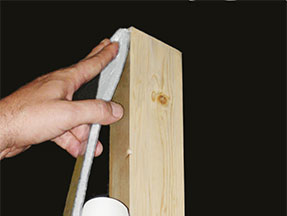Thermablok® FAQs
Frequently Asked Questions About Thermablok®
Download our Thermablok Data Sheet [PDF] for quick reference.
Click here to learn more about Aerogel and how it is made.
Download this summary of test results [PDF] for examples of Department of Energy testing of Thermablok material.
Thermablok is a perfect fit for a retrofit. Depending on whether the outer shell is being removed or not, Thermablok’s thermal bridging barrier insulation can be placed on either the outside or the inside of the wall studs. Extend the full length of the framing members and apply to all wall, floor or ceiling framing edges, headers, footers, trusses, window and door frames, floor joist and roof rafters. With metal framing you are able to create a warm stud, preventing condensation.
Budgetary cost estimates are not yet available. For guidance in planning and estimating, please see our Installation page, and you can download the Thermablok installation guide [PDF].
Thermablok material has Cradle to Cradle Silver Certification. One LEED point can be obtained through the use of at least 5% Cradle to Cradle Silver certified products. building materials. Energy Star certification is now in progress and will be announced on our Technical Data page when completed. Contact our sales staff at +1-813-980-1400 for current certification information.
Thermablok is available in custom widths. Only the Thermablok strips (1-1/2″ width) are encased on a self-adhesive plastic sleeve. Call 813-980-1400 for pricing and availability.
Yes, Thermablok is available in rolls, 60 inches (1.5m) wide and up to 155 fee (47M) long. Call 813-980-1400 for pricing and availability.
Thermablok thermal bridging barrier insulation can be applied to existing homes during remodeling. The application of Thermablok strips are to interior or exterior (preferred_ face of a wall stud, header, footer and window & door frames, and/or in the flooring joists. Thermablok can be used in the attic on the stud face to break the thermal bridging when enclosing and finishing an attic area.
It is generally better from a building science point of view to put the Thermablok on the exterior face of framing members if you will be able to access the entire building envelope, and between floor joists and other areas that are no t accessible from the inside.
From a structural standpoint, if there are shear wall considerations, then the Thermablok should go to the inside: we have not done any tests to measure the impact of Thermablok on the shear and racking strength of a wall.
From a labor standpoint, it is generally better to put the Thermablok on the inside. The labor requirements for a drywall crew working in the building’s interior to install Thermablok, are much less than the labor requirements of a framing crew installing Thermablok on the building’s exterior.
A slight amount of thermal bridging will occur through the metal of the drywall screw. To eliminate the impact of this bridging, Thermablok can be applied to both the interior and exterior faces of the wall stud.
All common construction adhesives will bond with Thermablok, but we do not recommend installation of drywall over Thermablok without mechanical fasteners. Install drywall or other wallboard with conventional fasteners according o manufacturer’s instruction.
Thermablok blanket material is ideal for this application because of the small amount of space (1/4 inch) required. Call us at 813-980-1400 to discuss your application with a technical support specialist.
Thermablok is intended for use inside wall and ceiling assemblies, and provides major energy savings when installed as part of a remodeling or retrofit project. For air leaks, a conventional form of insulation or weather stripping should be used.
Thermablok is not the most cost effective solution for this application.
Can lights designed for high insulation value and energy efficiency are now available and we recommend them for this application.
If you are re-roofing the house, Thermablok can be attached to roof rafters to virtually eliminate thermal bridging. If the attic studs are exposed and you are going to insulate the wall cavity between the stud and install covering materials for the ceiling, attach Thermablok to the interior side of the studs to prevent thermal bridging.
Yes, Thermablok can be used to replace expensive extruded polystyrene insulation to block thermal loss though metal studs.
Call us at 813-980-1400 tp discuss your application with a technical support specialist.
Please request a sample via our online contact form. Our Technical Data Sheets for Thermablok [PDF] strips and blanket material may be useful as well.
Thermablok is always interested in partnering with companies developing applications for aerogel composite insulation materials. Call us at 813-980-1400 to discuss your application with a technical support specialist.
Thermablok utilizes Aerogel Technology. Aerogels are very low density materials with extraordinarily low thermal and acoustic conductivity. Aerogels typically consist of 90 to 99% air, making them highly effective insulators, having the lowest thermal conductivity of any solid. Aerogels are composed of a network of interconnected nanoparticles. Their nanoscale structure resembles a sponge. Thermablok Aerogel is comprised of silica aerogel, which is a superior conductive insulator.


